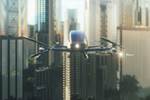Carbon fiber Hartzell propeller drives fuel cell-powered Dash 8
Specially designed five-bladed propeller keeps Universal Hydrogen hydrogen-testbed aircraft airborne during a flight in early March 2023, giving support to green technologies.
Universal Hydrogen’s (Hawthorne, Calif., U.S.) De Havilland Dash 8 hydrogen fuel cell-powered testbed first flew in early March 2023, its powertrain included a propeller designed and tested for the experimental aircraft by Hartzell Propeller (Piqua, Ohio, U.S.).
The 91-inch diameter, five-blade swept airfoil carbon fiber propeller uses derivative blades, hub and retention components from an existing 14 CFR Part 35 certified propeller. The specially designed Hartzell propeller is smaller than the standard Dash 8 propeller, but provided thrust to keep the aircraft airborne when the other jet fuel-powered turbine engine was throttled back during first flight.
“This project with Universal Hydrogen is one of many programs where Hartzell Propeller is working with and supporting advanced air mobility [AAM] manufacturers,” Hartzell Propeller President JJ Frigge says. “Hartzell Propeller has been around for over a hundred years, and carbon-free flight can power our next century. We’ve been working with this team for almost two years as we step up our investments working on future new aircraft design opportunities. Hartzell Propeller is pleased to be a part of this historic first flight of a hydrogen fuel cell-powered regional airliner.”
Hartzell says it also customized a governor for Universal Hydrogen and continues to develop governor advancements for green-powered aircraft. In this first test flight, one of the airplane’s turbine engines was replaced with Universal Hydrogen’s fuel cell-electric, megawatt-class powertrain. The other aircraft engine was powered by conventional fossil fuel for safety.
Universal Hydrogen’s first flight reportedly marked the largest hydrogen fuel cell-powered airplane to take to the skies and the largest airplane to cruise principally on hydrogen. The airplane, nicknamed “Lightning McClean,” flew for 15 minutes, reaching an altitude of 3,500 mean sea level (MSL). The flight was conducted under a Federal Aviation Administration (FAA) Special Airworthiness Certificate and the program is planned to culminate in 2025 with entry into passenger service of ATR 72 regional aircraft converted to run solely on hydrogen.
Related Content
-
Next-generation airship design enabled by modern composites
LTA Research’s proof-of-concept Pathfinder 1 modernizes a fully rigid airship design with a largely carbon fiber composite frame. R&D has already begun on higher volume, more automated manufacturing for the future.
-
Plant tour: Middle River Aerostructure Systems, Baltimore, Md., U.S.
The historic Martin Aircraft factory is advancing digitized automation for more sustainable production of composite aerostructures.
-
A new era for ceramic matrix composites
CMC is expanding, with new fiber production in Europe, faster processes and higher temperature materials enabling applications for industry, hypersonics and New Space.

















